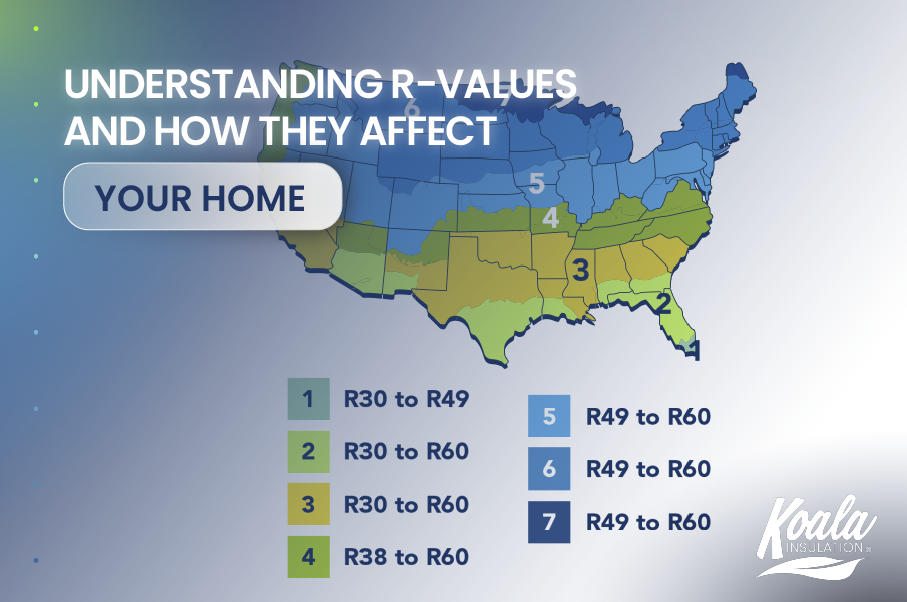Understanding R-Values and how they affect your home

R-values are an important factor to consider when making decisions about the energy efficiency of your home. R-values are the measure of a material’s resistance to the transfer of heat. The higher the R-value, the greater the insulating power of that material. In other words, the higher the R-value, the better the insulation is at keeping the heat in or out of your home.
When talking about insulation, you need to understand the importance of heat flow which is equal to energy flow. Heat transfers in three different ways: conduction, convection and radiation. Conduction is heat being transferred through physical contact; It is the fastest transfer of heat. Convection on the other hand is heat transfer through liquids and gasses and the reason why warmer air rises and colder air sinks to the ground. Radiation is a heat transfer that warms up anything solid that will absorb its energy, the best example for this would be the sun radiating heat to other planets.
Regardless of the type of thermal transfer, heat always flows from warmer to cooler to eliminate the temperature difference. That's the reason why the Miami & Fort Lauderdale heat might enter your non- or badly-insulated home and make your A/C work overtime. Properly insulating your home will give your house the resources to resist heat flow.
Insulation means creating a barrier to reduce the thermal transfer between the hot and the cold space either by reflecting thermal radiation or decreasing convection and conduction. The effectiveness of the insulation depends heavily on the material of that barrier. Most common insulation materials work by slowing down conductive heat flow as well as convective heat flow – the latter less efficiently. Radiant barriers reduce, as the name suggests, radiant heat flow into your home but are actually not rated with R-Values.
In most climates, a higher R-value is better. Higher R-values mean better insulation and a more comfortable home environment. In addition, higher R-values help reduce your energy bills by keeping your home cooler in the summer and warmer in the winter. When considering R-values, it’s important to take into account the type of material you’re using to insulate your home. For example, the R-value of fiberglass insulation is much higher than that of cellulose insulation. If you’re looking for the most efficient insulation, you should use the material with the highest R-value.
R-Values
The topic of the effectiveness of insulation is where R-Values come into play. The term "R-Value" is derived from "Thermal Resistance". The R-Value of an insulating material tells you how well that type of insulation will keep the heat from entering your Miami or Fort Lauderdale home and the value depends on the type, thickness and density of the material but also the temperature, age and moisture accumulation. That means that, in the same way we measure the level of energy (heat) in an object by determining its temperature, we can measure the ability of a material to resist temperature changes by its R-Value.
You might think now, that going all out will give you maximum heat resistance. But the R-Value is only one factor in your overall insulation performance. Windows, doors, studs and air leakes are not covered by standard insulation and allow for conductive heat transfer. Other insulating procedures, like for example air sealing, can help you get to that maximum heat resistance. Our team at Koala Insulation of Miami & Fort Lauderdale could help you determine what combination of methods would best protect your home.
What type of insulation has the highest R-Value?
The R-value for blown-in insulation ranges from 2.7 to 3.3 per inch, and depends on the material used as well as whether or not it is loosely or densely packed. It should be noted that, while both blown-in and batts can be made with the same materials, the R-value depends on the density, meaning that blown-in fiberglass will have a lower R-value than fiberglass batts.
Batt insulation R-values, which measures the ability of the material to resist heat flow, range from 3.1 to 3.7 per inch; this means, for example, that a 3.5-inch thick batt will have an R-value of 15 and an 8-inch thick batt will have one of 25. Depending on where you live, you will want a higher or lower R-value.
The R-value per inch for spray foam varies, depending on whether or not one chooses open cell or closed cell, with closed offering the highest rating. For this type of insulation, it’s not just about the R-value. Each type (open or closed) has its own properties that make it more – or less – effective. For example, those building a new residential or commercial property should look into closed cell spray foam as it is more useful when it comes to vapor control. If you're looking at retrofit insulation, so adding insulation to your existing home, open cell spray foam is a better option for you. In general, spray foam insulation offers premium protection for your home as it fills all gaps and cavities and therefore reduces air and heat flow. However, it is important to look at all characteristics of the different types of insulation and talk to a professional to ensure that you get the best solution for your house.
What R-Value do I need?
The amount of insulation you need in your home depends on the climate you live in, the part of your house you would like to insulate and the HVAC system you have. While getting insulation with an R-7 value might be tempting if you're looking for the best, it does not make sense in the Miami & Fort Lauderdale (Zone 1) climate and would be potentially wasteful and unnecessarily expensive. The best insulation is the one that fits your home and its environment's conditions.
Overall, R-values are an important factor to consider when making decisions about the energy efficiency of your home. The higher the R-value, the better the insulation and the more comfortable your home will be. It’s important to take into account the type of material you’re using, where you’re installing the insulation, and the climate you live in when selecting the R-value of your insulation. By doing so, you can ensure that your home is as energy efficient as possible and that you’re saving money on your energy bills.
At Koala Insulation of Fort Lauderdale and Miami, we understand the importance of selecting the right type of insulation for your home. Our team of experienced professionals can help you select the insulation with the highest R-value for your home and climate, ensuring that your home is as energy efficient as possible and that you’re saving money on your energy bills. Contact us today to learn more about our insulation services.
Source Map & Table: energystar.gov
Find Your Location


Get a quote



